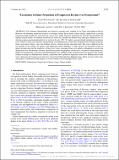Uncertainty in future projections of precipitation decline over Mesopotamia
Author(s)
Choi, Yeon-Woo; Eltahir, Elfatih AB
DownloadPublished version (5.285Mb)
Publisher Policy
Publisher Policy
Article is made available in accordance with the publisher's policy and may be subject to US copyright law. Please refer to the publisher's site for terms of use.
Terms of use
Metadata
Show full item recordAbstract
<jats:title>Abstract</jats:title>
<jats:p>For millennia, Mesopotamia was blessed by enough water supplied by the Tigris and Euphrates Rivers. However, the dwindling freshwater resource is no longer enough. In the future, climate change coupled with a growing population could considerably exacerbate the current water deficit. Based on simulations by carefully selected global and regional climate models, we conclude that these river basins may possibly face further water shortages (mainly due to a reduction in spring-season precipitation) in the next few decades (2021–50) under a scenario of high emissions of greenhouse gases. However, there is no consensus among models regarding these near-term (2021–50) projections of change in precipitation, and society is likely to face the challenge of how to prepare for this uncertain future. The story is different for the late decades of this century: we project, with significantly more confidence, a robust decrease in wet-season (winter to spring) precipitation over the headwaters of these river basins, worsening future water deficits and implying a century-long drying trend over Mesopotamia. Possible physical mechanisms are proposed and discussed. As global warming progresses, higher sea level pressure, centered on the Mediterranean Sea, will likely make upstream storms less frequent and weaker, leading to drying over Mesopotamia. Further, projections show a poleward migration of the fewer Mediterranean storm tracks, decreasing the frequency of storms that penetrate into Mesopotamia. Implementing a global net-zero carbon emissions policy by midcentury could mitigate the severity of the projected droughts in this region.</jats:p>
Date issued
2022Department
Massachusetts Institute of Technology. Department of Civil and Environmental EngineeringJournal
Journal of Climate
Publisher
American Meteorological Society
Citation
Choi, Yeon-Woo and Eltahir, Elfatih AB. 2022. "Uncertainty in future projections of precipitation decline over Mesopotamia." Journal of Climate, 36 (4).
Version: Final published version